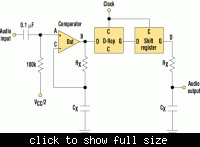sisso
Newbie level 4

Someone tell me circuit diagram of a 1-bit Analog to Digital converter with chip no.'s mentioned. All the things resistors,capacitors with proper values mentioned.
I want to create a device that reads 5V DC signal and convert it into binary signal. Then this binary signal is transferred to USB port of a PC and an application reads it.
I want to create a device that reads 5V DC signal and convert it into binary signal. Then this binary signal is transferred to USB port of a PC and an application reads it.




